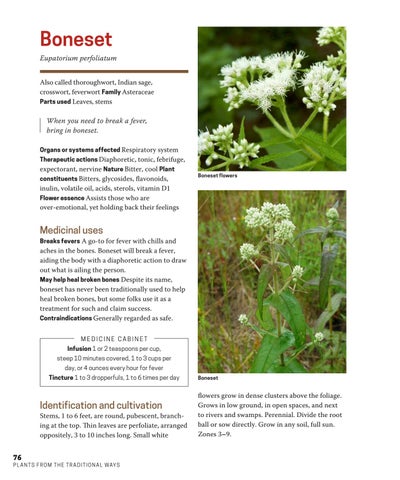Boneset Eupatorium perfoliatum Also called thoroughwort, Indian sage, crosswort, feverwort Family Asteraceae Parts used Leaves, stems
When you need to break a fever, bring in boneset. Organs or systems affected Respiratory system
Therapeutic actions Diaphoretic, tonic, febrifuge, expectorant, nervine Nature Bitter, cool Plant constituents Bitters, glycosides, flavonoids, inulin, volatile oil, acids, sterols, vitamin D1 Flower essence Assists those who are over-emotional, yet holding back their feelings
Boneset flowers
Medicinal uses Breaks fevers A go-to for fever with chills and aches in the bones. Boneset will break a fever, aiding the body with a diaphoretic action to draw out what is ailing the person. May help heal broken bones Despite its name, boneset has never been traditionally used to help heal broken bones, but some folks use it as a treatment for such and claim success. Contraindications Generally regarded as safe. MEDICINE CABINET Infusion 1 or 2 teaspoons per cup, steep 10 minutes covered, 1 to 3 cups per day, or 4 ounces every hour for fever Tincture 1 to 3 dropperfuls, 1 to 6 times per day
Identification and cultivation Stems, 1 to 6 feet, are round, pubescent, branching at the top. Thin leaves are perfoliate, arranged oppositely, 3 to 10 inches long. Small white 76 P L A N T S F R O M T H E T R A D I T I O N A L WAY S
Boneset
flowers grow in dense clusters above the foliage. Grows in low ground, in open spaces, and next to rivers and swamps. Perennial. Divide the root ball or sow directly. Grow in any soil, full sun. Zones 3–9.
